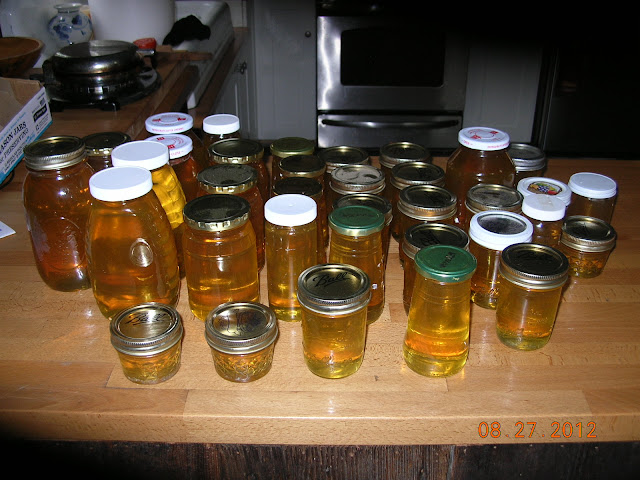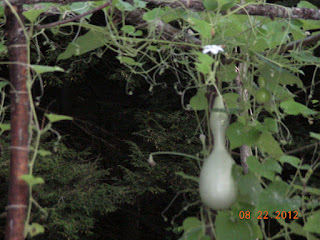Keeping out pests in a garden is one of gardening's biggest challenges. I think that about a month or so ago...or less, I wrote something about how lovely my tomatoes were. This photo was taken on July 12th
But then something began to happen. I noticed large bites out of the tomatoes as soon as they began ripening. I had to begin picking early so that I'd get a tomato crop. and my crop has been good...but it could have been better if it weren't for this "large bite out of tomato" situation.
Yesterday, I was in the woods around my house looking for mushrooms, and I saw a couple of green tomatoes with tooth marks on them...like they half attempted to save them, but in the end, dropped..probably knowing there was better fruit to be had in another day or so.
I also think my heirloom pineapple tomato plant tricked them for a while because they were yellowing but not reddening and they escaped getting the bites taken out of them. But after a few weeks, even they began to have bites. I wondered if the creature(s) determine ripeness via color, or scent or perhaps touch? The photo above is one of the pineapple tomatoes..so this is proof that they've been discovered.
Also the dreaded late season blight hit the tomatoes. I have struggled with that for a
few years, as we all have. I did purchase some seeds that were
resistant but I also had heirlooms which are not resistant, so the
disease came, but it came late.
Late summer blight on tomatoes
About the only thing you can do at this point is to cut off all the dead or diseased leaves and bag them in plastic immediately and then throw them into the trash. Never throw this onto the compost pile since it will infect plants in coming years. The disease spreads by spores so you don't want these floating through the air.
I cut them off this morning so the plants look pretty naked. But sometimes they come back if you cut off all the disease. Because we should have at least another month of growing season, I will add some fertilizer and see what happens. I have nothing to lose at this point.
And then cucumber beetles attacked the summer squash and decimated it overnight. I reached for a pesticide with them because I didn't want to lose my zucchini, cucumbers and melons and pumpkin too! It worked. The others are still doing ok. But I lost the summer squash and pulled it and added to the dead tomatoes in plastic.
Then, one morning last week, I look out to see most of my corn flattened to the ground. I knew this was a bear. Only a bear would trash the entire area, and I could picture him or her sitting in the middle of all the chaos eating the corn and dropping the cob.
There is literally nothing left on the corn cob. You know how,when you finish an ear of corn, there's always remnants of the outer kernal left behind? There is nothing on these cobs. They were ready to use in decorations, almost dry! Well, perhaps a slight exaggeration but they were very much cleaned off.
Between, the tomatoes and the bear, and the turkeys, and God knows, the chipmunks and squirrels, I need something to deter them. So I'm planning to put in a fence. For the past few years, a product called Repels All has worked out really well...it's coyote urine packaged into a powder or spray that you can sprinkle or spray around your garden or plants you want to protect. It's worked before but not this year. Maybe because this is the best garden I've had here so far.
I think I'll buy the fence prior to next spring so it's ready to go. Maybe even within a few weeks. If I can do within a few weeks, it might even save a little of this crop, especially if first frost is very late like it was last year. I'll include my pear trees within the fenced area too, hoping to help them keep their crop, a small crop, hopefully, next year.
But will a 5-foot wire fence keep out a bear? Or deer? It will at least deter them. If I have to, I'll have to electrify my garden fence too. I just don't want to deal with that with children around, but of course, I will always shut it off when they come. These will be things to think about over the coming days, weeks and months.
Another fall plan is to add a pathway to my front steps, using the wood chips, like I did on the side of the house. I already started demolition by moving some plants from there to another part of the front yard. And I want two sections of picket fence out front near the driveway so that plows can't plow snow onto the front lawn. They practically ruined it last year and plowed into this beautiful shrub that, to me at least, is a centerpiece of the lawn. That's a subject for another day.
































 The piece of wood you see across the top if this has a screw in the middle that you rest the frame on as you are running the comb down over the frame to allow the honey to flow.
The piece of wood you see across the top if this has a screw in the middle that you rest the frame on as you are running the comb down over the frame to allow the honey to flow.













